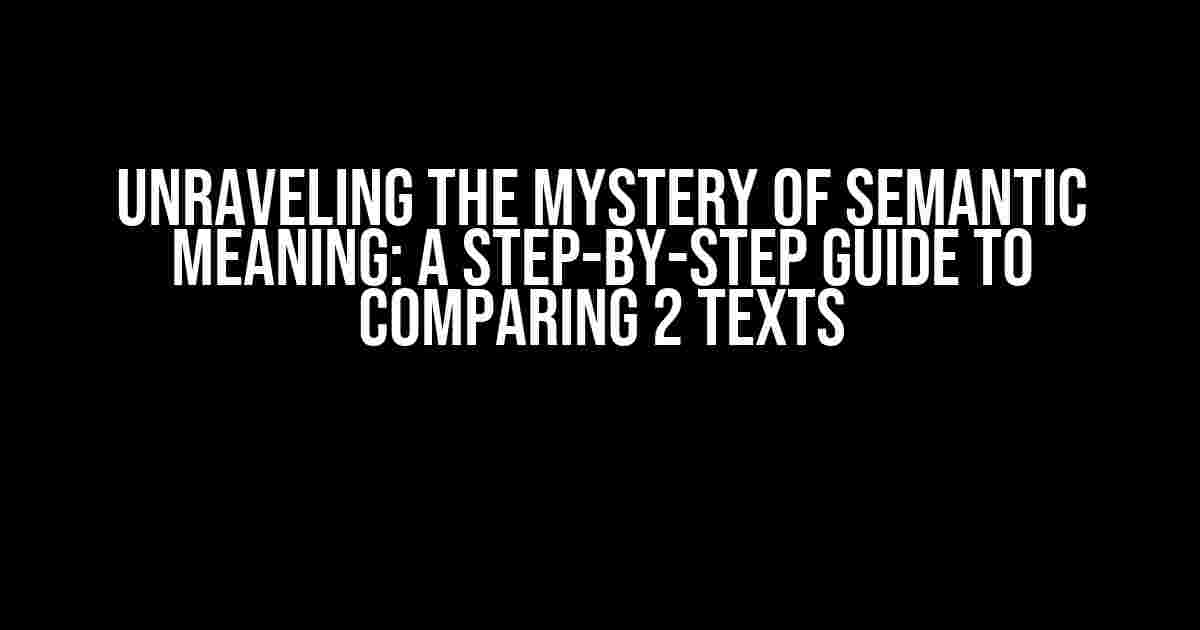When it comes to understanding the nuances of language, comparing two texts can be a daunting task. But what if I told you there’s a way to break down this process into manageable chunks, ensuring you grasp the semantic meaning of each text and its relationship with the other? In this article, we’ll embark on a journey to demystify the art of analyzing two texts while considering the order of the texts. So, buckle up and let’s dive in!
- Step 1: Read and Understand Each Text Individually
- Step 2: Identify the Purpose and Audience of Each Text
- Step 3: Compare and Contrast the Texts
- Step 4: Analyze the Order of the Texts
- Step 5: Draw Conclusions and Identify Implications
- Bonus Step: Visualize the Relationship Between the Texts
- Conclusion
Step 1: Read and Understand Each Text Individually
Before we start comparing, it’s essential to understand each text on its own terms. Take the time to read each text carefully, taking note of the following elements:
- Main idea or thesis statement
- Supporting arguments or evidence
- Tone and point of view
- Language and style
- Key terms and concepts
As you read, ask yourself questions like:
- What is the author trying to convey?
- What emotions or reactions am I experiencing while reading this text?
- What are the implications of the author’s claims?
Step 2: Identify the Purpose and Audience of Each Text
Understanding the purpose and intended audience of each text is crucial in grasping its semantic meaning. Ask yourself:
- What is the author’s purpose? (e.g., persuade, inform, entertain)
- Who is the intended audience? (e.g., experts, general public, children)
- How does the author’s purpose influence the language and tone?
For example, if the purpose of one text is to persuade, the author may use more emotive language and rhetorical devices to sway the reader. On the other hand, an informative text might employ a more neutral tone and focus on presenting facts.
Step 3: Compare and Contrast the Texts
Now that you have a solid understanding of each text individually, it’s time to compare and contrast them. Create a table or chart to help you visualize the similarities and differences:
| Element | Text 1 | Text 2 |
|---|---|---|
| Main Idea | … | … |
| Tone | … | … |
| Language | … | … |
| Key Terms | … | … |
Look for patterns, similarities, and differences in:
- Main ideas and supporting arguments
- Tone and language
- Key terms and concepts
- Author’s purpose and audience
Step 4: Analyze the Order of the Texts
The order in which you read the texts can significantly impact your understanding of their semantic meaning. Ask yourself:
- How does reading Text 1 first influence my interpretation of Text 2?
- Do I perceive Text 2 as a response to or a continuation of Text 1?
- How would my understanding change if I read Text 2 first?
Consider the potential biases and assumptions that come with reading the texts in a particular order. Be aware of how your own experiences and prior knowledge might influence your interpretation.
Step 5: Draw Conclusions and Identify Implications
Based on your analysis, draw conclusions about the semantic meaning of each text and their relationship with each other. Ask yourself:
- What insights do I gain from comparing these two texts?
- How do the texts challenge or reinforce my existing knowledge?
- What are the implications of these texts for real-world applications or future research?
Remember to support your conclusions with evidence from the texts and your analysis.
Bonus Step: Visualize the Relationship Between the Texts
To further solidify your understanding, try creating a visual representation of the texts and their relationships. This could be a:
- Venn diagram to illustrate similarities and differences
- Flowchart to show the flow of ideas between texts
- Mind map to highlight key concepts and connections
+---------------+
| Text 1 |
+---------------+
|
|
v
+---------------+
| Similarities |
+---------------+
|
|
v
+---------------+
| Text 2 |
+---------------+
By following these steps, you’ll gain a deeper understanding of the semantic meaning of each text and their relationships with each other. Remember to consider the order of the texts and how it influences your analysis. With practice, you’ll become a master of unraveling the mysteries of language and meaning!
Conclusion
Comparing two texts while considering the order of the texts is a complex task that requires patience, attention to detail, and a willingness to consider multiple perspectives. By breaking down the process into manageable steps, you can unlock the secrets of semantic meaning and develop a deeper appreciation for the intricacies of language. So, the next time you’re faced with comparing two texts, remember to take your time, stay curious, and let the magic of meaning reveal itself!
Frequently Asked Question
Get the most out of comparing two texts by understanding their semantic meaning and the significance of their order!
Why is it important to consider the order of the texts when checking their semantic meaning?
Considering the order of the texts is crucial because it can alter the meaning of the entire narrative. The author’s intention, tone, and context might change depending on the order in which the texts are presented. By analyzing the order, you can better understand the relationships between ideas, identify causality, and make more accurate inferences.
How do I identify the semantic meaning of each text individually before comparing them?
To identify the semantic meaning of each text, focus on understanding the author’s intended message, tone, and purpose. Identify the keywords, phrases, and sentences that convey the main idea. Pay attention to the context, implied meaning, and any ambiguity or subtlety in the language. This will help you to create a mental representation of the text’s meaning before comparing it with the other text.
What are some potential pitfalls to avoid when comparing the semantic meaning of two texts?
Some common pitfalls to avoid include: 1) assuming the texts are identical in meaning without careful analysis, 2) overlooking the importance of context and tone, 3) failing to recognize ambiguities or subtleties in language, and 4) making unjustified inferences or jumping to conclusions. Be patient, thorough, and objective in your analysis to ensure accurate comparisons.
Can the order of the texts affect the level of coherence between them?
Yes, the order of the texts can significantly impact the level of coherence between them. A well-structured sequence of texts can create a cohesive narrative, while a jumbled or illogical order can disrupt coherence and make it difficult to understand the relationships between ideas. Pay attention to how the author structures the texts to create a cohesive whole.
How can I visualize the relationships between the semantic meanings of the two texts?
Visual aids like diagrams, flowcharts, or concept maps can help you illustrate the relationships between the semantic meanings of the two texts. Identify key concepts, ideas, and relationships, and use arrows or lines to represent how they connect. This will enable you to visualize the similarities, differences, and relationships between the texts, making it easier to identify patterns and meaning.


